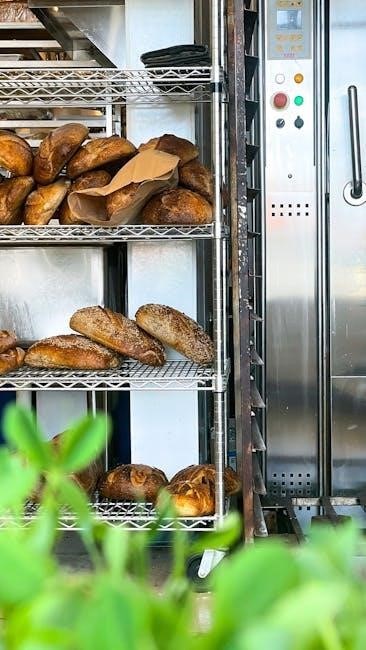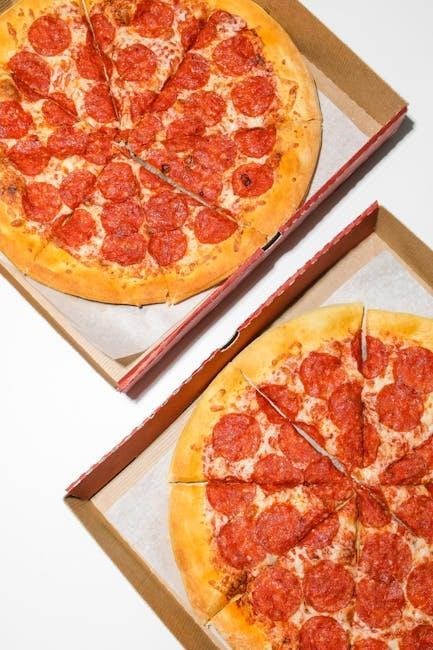NuWave Oven Operating Instructions: A Comprehensive Guide
Welcome to a comprehensive guide designed to help you master your NuWave Oven! This resource provides step-by-step instructions for efficient and safe usage, unlocking its full potential.
Understanding Your NuWave Oven
Before diving into cooking, familiarize yourself with your NuWave Oven’s innovative technology. This appliance uses a combination of infrared, convection, and conduction heat to cook food quickly and evenly, often directly from frozen. Unlike traditional ovens, the NuWave minimizes preheating time and energy consumption.
Understanding the components is crucial. The power head houses the controls, while the dome traps heat. Different racks enable multi-level cooking, and the liner pan catches drippings. The NuWave Oven is designed for healthy cooking, reducing the need for added fats. Its efficient air flow ensures crispy results, similar to frying, but with less oil.
Explore the user manual for specific model features. By grasping these core principles, you’ll be well-equipped to maximize your NuWave Oven’s capabilities, achieving delicious and nutritious meals with ease.

Getting Started
Let’s begin your NuWave Oven journey! This section covers the initial setup, familiarizing you with its components, and essential preheating instructions for optimal cooking performance every time.

Initial Setup and Components
Before your first culinary adventure, ensure a proper setup. Unpack all NuWave Oven components carefully. You should have the power head, dome, base, and cooking rack. Familiarize yourself with each part.

The power head houses the controls; the dome creates a contained cooking environment. The base supports the unit, and the rack elevates food for even cooking. Consult your manual for a detailed parts diagram.
Wash the dome and rack with warm, soapy water and dry thoroughly. Place the base on a stable surface with adequate ventilation. Connect the power head securely to the dome. Now, you’re ready to explore the NuWave Oven’s capabilities and unlock delicious possibilities!
Preheating Instructions
While not always necessary, preheating can enhance certain recipes, particularly for achieving optimal browning or crisping. To preheat your NuWave Oven, ensure the unit is properly assembled and placed on a stable surface.
Set the desired cooking temperature using the control panel. Allow the oven to run empty for approximately three to five minutes; This allows the internal temperature to stabilize, creating a consistent cooking environment.
For recipes that specifically call for preheating, this step is crucial for achieving the desired results. However, many dishes can be cooked directly from a cold start, saving time and energy. Refer to your recipe for specific preheating recommendations. Always exercise caution when handling the hot dome after preheating.

Basic Operation
Understanding the NuWave Oven’s basic functions is crucial for successful cooking. This section covers setting time and temperature, using the delay timer, and cooking from frozen for convenient meal preparation.
Setting the Cooking Time and Temperature
Mastering the NuWave Oven involves accurately setting the cooking time and temperature. Begin by consulting your recipe or the NuWave Oven’s cooking guide for recommended settings. Use the control panel to input the desired cooking time, adjusting minutes as needed for precision.
Next, set the temperature according to the recipe. The NuWave Oven offers a range of temperatures, allowing you to cook various dishes effectively. Ensure the temperature is appropriate for the food you’re preparing to achieve optimal results.
For consistent cooking, monitor the internal temperature of your food using a meat thermometer. This ensures that your food reaches a safe and desirable level of doneness. Adjust the cooking time and temperature as necessary, based on your observations and the specific requirements of the recipe. Always prioritize food safety when operating the NuWave Oven.

Using the Delay Timer

The NuWave Oven’s delay timer offers unparalleled convenience for meal planning. To utilize this function, first, prepare your dish and place it inside the oven. Next, consult your recipe for the recommended cooking time and temperature settings.
On the control panel, locate the delay timer function. Set the desired delay time, specifying when you want the cooking process to begin; Ensure the time is accurately programmed to align with your schedule.
Once the delay time is set, verify all settings and activate the timer. The NuWave Oven will remain idle until the specified time, then automatically initiate the cooking cycle. This feature allows you to prepare meals in advance, ensuring a hot, freshly cooked dish is ready when you need it, even when you’re busy. Always ensure food safety when using the delay timer.
Cooking from Frozen
One of the most convenient features of the NuWave Oven is its ability to cook food directly from frozen, eliminating the need for thawing. This saves valuable time and simplifies meal preparation, especially on busy days.
To cook frozen items, place them directly onto the cooking rack inside the NuWave Oven. Refer to the cooking chart or recipe for the appropriate time and temperature adjustments. Typically, cooking frozen foods requires a slightly longer cooking time than thawed items.
Monitor the food’s internal temperature using a meat thermometer to ensure it reaches a safe consumption level. The NuWave Oven’s infrared technology helps cook food evenly, even from a frozen state.
For best results, consider flipping the food halfway through the cooking process to ensure thorough and even cooking. Enjoy the convenience of cooking delicious, perfectly cooked meals straight from the freezer with your NuWave Oven.

Cooking Specific Foods
The NuWave Oven excels at cooking a variety of foods. This section provides specific instructions and tips for achieving optimal results with chicken, frozen breaded chicken, and sausage.
Cooking Chicken
Achieving perfectly cooked chicken in your NuWave Oven is simple with the correct settings and techniques. First, ensure your chicken is fully thawed for even cooking. Place the chicken on the included rack to allow for proper air circulation. For a whole chicken (approximately 3-4 lbs), set the oven to high power for 12-15 minutes per pound.
Check the internal temperature using a meat thermometer; it should reach 165°F (74°C). For chicken pieces like breasts or thighs, adjust the cooking time accordingly, usually around 20-25 minutes depending on thickness. Season your chicken with herbs, spices, or marinades before cooking to enhance flavor.
Remember to use oven mitts when handling hot components. Let the chicken rest for a few minutes before carving to retain its juices. Enjoy your delicious and healthy NuWave Oven-cooked chicken!
Cooking Frozen Breaded Chicken
The NuWave Oven excels at cooking frozen breaded chicken, eliminating the need for thawing. Place the frozen breaded chicken pieces directly onto the elevated cooking rack to ensure even heating and crisping. Avoid overcrowding the rack for optimal results.
Set the NuWave Oven to high power. Typically, frozen breaded chicken breasts or tenders require approximately 20-25 minutes, but this can vary depending on thickness and the specific product. Halfway through cooking, flip the chicken pieces to ensure even browning and crispness on all sides.
Always check the internal temperature using a meat thermometer; ensure it reaches 165°F (74°C) for safety. Allow the chicken to cool slightly before serving. Enjoy the convenience and deliciousness of perfectly cooked frozen breaded chicken from your NuWave Oven!
Cooking Sausage
Cooking sausage in the NuWave Oven is straightforward and efficient. For best results, place the sausages on the elevated cooking rack to allow for even heat circulation. This helps to render the fat and achieve a nicely browned exterior. Ensure the sausages are spaced apart to prevent steaming.
Set the NuWave Oven to high power. The cooking time will vary depending on the type and thickness of the sausage. As a general guideline, cook sausages for approximately 15-20 minutes, flipping them halfway through to ensure even cooking and browning on all sides.
Use a meat thermometer to verify that the internal temperature reaches 160°F (71°C) for pork sausage and 165°F (74°C) for poultry sausage. Let the sausages rest for a few minutes before serving. Enjoy perfectly cooked sausage, browned and juicy, courtesy of your NuWave Oven!

Cleaning and Maintenance
Proper cleaning and maintenance are essential for prolonging the life of your NuWave Oven. Regular care ensures optimal performance and prevents build-up, keeping your oven ready for delicious meals.
Cleaning the Components
Maintaining a clean NuWave Oven is crucial for optimal performance and food safety. After each use, allow the oven to cool completely before disassembling the components for cleaning. The dome, base tray, and cooking rack can be washed with warm, soapy water. Use a non-abrasive sponge or cloth to avoid scratching the surfaces. For tougher stains, a mild dish soap solution can be used. Ensure all soap residue is thoroughly rinsed off before reassembling.
The power head should only be wiped down with a damp cloth; never immerse it in water or any other liquid, as this could cause electrical damage. Periodically check the heating element for any food debris and gently clean it with a dry cloth. Regular cleaning prevents buildup, ensuring consistent cooking results and prolonging the lifespan of your NuWave Oven. Always refer to the user manual for specific cleaning instructions and recommendations.
Troubleshooting Common Issues
Encountering issues with your NuWave Oven can be frustrating, but many problems have simple solutions. If the oven isn’t turning on, first ensure it’s properly plugged into a functioning outlet. Check the power cord for any damage. If the food isn’t cooking evenly, ensure it’s properly positioned on the cooking rack and that the dome is securely in place. Uneven cooking can also result from overcrowding the oven.
If you notice excessive smoke, reduce the cooking temperature or check if food debris has accumulated inside the oven. Burning smells might indicate food particles stuck to the heating element. If the timer isn’t working correctly, consult the user manual for reset instructions. For persistent problems, contacting NuWave customer support is advisable. Always refer to the troubleshooting section of your user manual for detailed guidance and solutions to common issues.

Safety Precautions
Prioritize safety when using your NuWave Oven. Always use oven mitts when handling hot components. Ensure proper ventilation during operation. Read the manual thoroughly before first use.
Handling Hot Components
When operating the NuWave Oven, it is crucial to exercise caution and prioritize safety, particularly when handling hot components. The oven’s dome, cooking rack, and other interior parts can reach extremely high temperatures during and immediately after use. To prevent burns and injuries, always use oven mitts or heat-resistant gloves when reaching into the oven or removing food.
Avoid touching the hot surfaces directly with bare hands. Allow the components to cool down completely before attempting to clean or store them. Be especially mindful of children and pets, ensuring they are kept away from the oven during and after operation to prevent accidental contact with hot surfaces. Never place flammable materials near the hot components, and always position the oven on a heat-resistant surface to avoid damage to countertops or tables. Taking these precautions will ensure a safe and enjoyable cooking experience with your NuWave Oven.
Proper Ventilation
Ensuring proper ventilation is essential when operating your NuWave Oven to maintain a safe and efficient cooking environment. The NuWave Oven generates heat and steam during the cooking process, and adequate ventilation helps to dissipate these byproducts, preventing condensation buildup and potential damage to surrounding surfaces.
Always operate the oven in a well-ventilated area, away from walls and cabinets, allowing sufficient airflow around the unit. Avoid placing the oven under low-hanging cabinets or in enclosed spaces, as this can restrict ventilation and lead to overheating. If possible, use the oven near an exhaust fan or open a window to further improve air circulation. Regularly check for any obstructions around the oven’s vents and clear them to ensure unrestricted airflow. Proper ventilation not only enhances safety but also contributes to the longevity and optimal performance of your NuWave Oven.